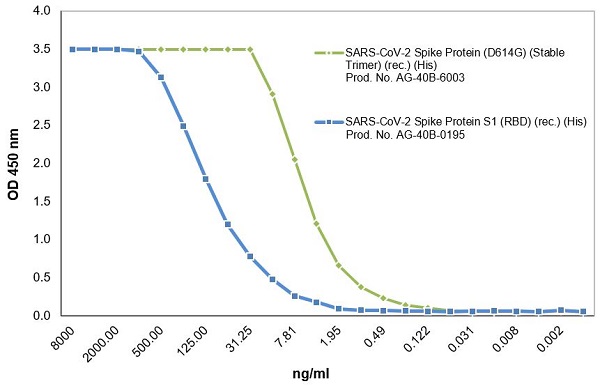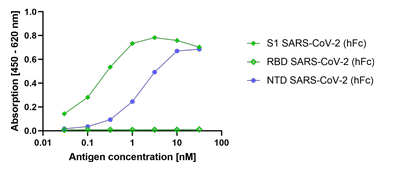
anti-SARS-CoV-2 Spike Protein S1 (NTD), mAb (rec.) (AB72-1-G09)
AG-27B-6307
ApplicationsELISA
Product group Antibodies
ReactivityVirus
TargetS
Overview
- SupplierAdipoGen Life Sciences
- Product Nameanti-SARS-CoV-2 Spike Protein S1 (NTD), mAb (rec.) (AB72-1-G09)
- Delivery Days Customer10
- ApplicationsELISA
- CertificationResearch Use Only
- ClonalityMonoclonal
- Clone IDAB72-1-G09
- Concentration1 mg/ml
- Estimated Purity>95%
- Gene ID43740568
- Target nameS
- Target descriptionsurface glycoprotein
- Target synonymsGU280_gp02, spike glycoprotein, surface glycoprotein
- HostMouse
- IsotypeIgG2a
- Protein IDP0DTC2
- Protein NameSpike glycoprotein
- Scientific DescriptionCoronaviruses (CoVs) are enveloped non-segmented positive-sense single-stranded RNA viruses and can infect respiratory, gastrointestinal, hepatic and central nervous system of human and many other wild animals. Recently, a new severe acute respiratory syndrome beta-coronavirus called SARS-CoV-2 (or 2019-nCoV) has emerged, which causes an epidemic of acute respiratory syndrome (called coronavirus human disease 2019 or COVID-19). SARS-CoV-2 shares 79.5% sequence identity with SARS-CoV and is 96.2% identical at the genome level to the bat coronavirus BatCoV RaTG133, suggesting it had originated in bats. SARS-CoV-2 contains 4 structural proteins, including Envelope (E), Membrane (M), Nucleocapsid (N) and Spike (S), which is a transmembrane protein, composed of two subunits S1 and S2. The S protein plays a key role in viral infection and pathogenesis. The S1 subunit contains the N-terminal domain (NTD) and a receptor binding domain (RBD), which binds to the cell surface receptor Angiotensin-Converting Enzyme 2 (ACE2) present at the surface of epithelial cells, causing mainly infection of human respiratory cells, whereas S2 harbors heptad repeat 1 (HR1) and HR2. The RBD domain first binds its receptor to form an RBD/ACE2 complex. This triggers conformational changes in the S protein, leading to membrane fusion mediated via HR1 and HR2 and consequently in viral entry into target cells. Antibodies targeting various regions of S protein have different mechanisms in inhibiting SARS-CoV-2 infection. For example, NTD-targeting antibodies bind the NTD to form an NTD/mAb complex, thereby preventing conformational changes in the S protein and blocking membrane fusion and viral entry. RBD-targeting antibodies form RBD/mAb or RBD/Nb complexes that inhibit binding of the RBD to ACE2, thereby preventing entry of SARS-CoV-2 into target cells. - Recombinant Antibody. Recognizes the SARS-CoV-2 S1 (N-terminal domain). Does not cross-react with HCoV-OC43, HCoV-229E, HCoV-NL63, HCoV-HKU1, MERS-CoV or SARS-CoV. Applications: ELISA. Clone: AB72-1-G09. Isotype: Mouse IgG2a. Formulation: Liquid. In PBS. Coronaviruses (CoVs) are enveloped non-segmented positive-sense single-stranded RNA viruses and can infect respiratory, gastrointestinal, hepatic and central nervous system of human and many other wild animals. Recently, a new severe acute respiratory syndrome beta-coronavirus called SARS-CoV-2 (or 2019-nCoV) has emerged, which causes an epidemic of acute respiratory syndrome (called coronavirus human disease 2019 or COVID-19). SARS-CoV-2 shares 79.5% sequence identity with SARS-CoV and is 96.2% identical at the genome level to the bat coronavirus BatCoV RaTG133, suggesting it had originated in bats. SARS-CoV-2 contains 4 structural proteins, including Envelope (E), Membrane (M), Nucleocapsid (N) and Spike (S), which is a transmembrane protein, composed of two subunits S1 and S2. The S protein plays a key role in viral infection and pathogenesis. The S1 subunit contains the N-terminal domain (NTD) and a receptor binding domain (RBD), which binds to the cell surface receptor Angiotensin-Converting Enzyme 2 (ACE2) present at the surface of epithelial cells, causing mainly infection of human respiratory cells, whereas S2 harbors heptad repeat 1 (HR1) and HR2. The RBD domain first binds its receptor to form an RBD/ACE2 complex. This triggers conformational changes in the S protein, leading to membrane fusion mediated via HR1 and HR2 and consequently in viral entry into target cells. Antibodies targeting various regions of S protein have different mechanisms in inhibiting SARS-CoV-2 infection. For example, NTD-targeting antibodies bind the NTD to form an NTD/mAb complex, thereby preventing conformational changes in the S protein and blocking membrane fusion and viral entry. RBD-targeting antibodies form RBD/mAb or RBD/Nb complexes that inhibit binding of the RBD to ACE2, thereby preventing entry of SARS-CoV-2 into target cells.
- ReactivityVirus
- Storage Instruction-20°C,2°C to 8°C
- UNSPSC12352203









